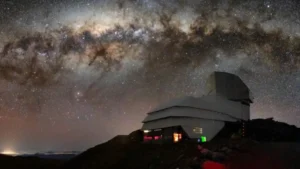Conditions on the surface of the sun have been unusually volatile lately — which is saying something for a place that’s made of electrified, roiling gas.
According to The Washington Post, NASA reported three “X-class” solar flares in the week leading up to Jan. 12. X-class flares are the strongest category for the magnetically charged solar events.
Solar flares are eruptions of energy, made of electromagnetic radiation traveling at the speed of light. They can increase the brilliance of the southern and northern lights, and knock out radio communications.
The recent flares have caused only moderate effects on Earth. But outcomes could intensify in the weeks to come.
Solar flares in brief
The currently high flare rate is part of the current “solar cycle,” which researchers use to measure the sun’s past activity and roughly forecast its future. We’re near the beginning of solar cycle 25, which many physicists have predicted will be moderate in terms of solar flares.
But according to the Post article, a few “bold” outliers have called for a stormier sun than the previous consensus. And the recent barrage indicates they may be right.
A solar flare erupts from a sunspot, which is a dark, low-temperature blotch on the sun’s surface made up of highly concentrated magnetic activity. The magnetic differential between a sunspot and the surrounding solar plasma makes the nearby magnetic fields fluctuate strongly.
Unbelievable, the Sun just produced its third X-class #SolarFlare in almost as many days! However, this time from a different active region than the first two. The Sun has two X-class-producing active regions on disk, making it difficult for observers choosing where to point 🔭 pic.twitter.com/396qOjNPnQ
— Dr. Ryan French (@RyanJFrench) January 11, 2023
Stretched like a rubber band, the fields can contort sharply and trigger an electromagnetic release into space — otherwise known as a solar flare.
The radiating energy can cause radio blackouts and sometimes cause interference or damage to satellites. Passengers and pilots on aircraft flying near the Earth’s poles can even come into harm’s way.
Coronal mass ejections (CMEs) can also accompany solar flares. If they erupt in the direction of Earth, damage here can be even more severe.
Cycles of flares and CMEs
Flares and CMEs happen proportionally to how many sunspots occur at any one time on the “solar disk” — the side of the sun visible from Earth. Sunspots appear most on the disk around the peak of an 11-year solar cycle. Physicists with the National Oceanic and Atmospheric Administration (NOAA) estimate that the peak of the current cycle will occur in 2025, when they predict about 115 sunspots per month.
However, the agency has observed almost exactly that many in early 2023.

Sunspot count (blue) versus predictions (red). Image: NOAA
The discrepancy falls closer in line with research from Scott McIntosh, deputy director of the National Center for Atmospheric Research, and Bob Leamon, a researcher at the University of Maryland Baltimore County and NASA Goddard.
Their calculations predict twice as many sunspots in 2025.
What’s happening now?
The three recent X-class solar flares erupted from two sunspot clusters that have recently rotated around the solar surface to face Earth more directly. On Jan. 9, radio blackouts in Australia and the South Pacific occurred from X flares.
If the flares link up with CMEs while their parent sunspots are facing Earth, harsher geomagnetic storms could prompt electric companies and satellite operators to take measures to protect valuable, sensitive electronics.
It’s not all bad. Auroral displays could be spectacular, potentially all the way down to latitudes including the northern United States, southern Europe, and China.






